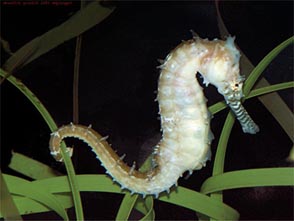Seahorses are covered with bony plates, not scales.
A seahorse's head looks a bit like a horse's head.
A seahorse dad carries the eggs in a pocket on his belly.
Sea dragon dads carry the eggs on their tail.
Sea dragons look like floating seaweed.
Seahorse ©Getty Images
Seahorses and sea dragons are fish. Both seahorses and sea dragons are unusual and beautiful, and are vulnerable.
What are seahorses?
There are over 50 different kinds of seahorse, different species in different countries. New ones are still being discovered by divers.
Habitat and Distribution (where they are found)
Seahorses are found in the warmer waters of the world, generally in shallower waters near coastlines.
Body and Appearance
Labelled diagram of a seahorse body ©kidcyber
Seahorses are not covered in scales like other fish. Instead they have bony plates that help protect their bodies. As seahorses do not have ribs, the bony plates do the job.
A sea horse holds onto weeds with its prehensile tail. Getty Images
Some kinds of seahorse develop spiky bits that look like twigs sticking out, and these help with camouflage. Seahorses change colour to match their surroundings. They do this by expanding or contracting the pigment cells in their skin. They can appear in many colours from white to black, greens, bright oranges and reds.
The tail is prehensile, which means it can wrap around seaweed to anchor the seahorse, where its upright body looks rather like a part of the plant. Seahorses have a dorsal fin that moves them forwards. On their sides they have pectoral fins, which help them steer. Their eyes move independently of each other.
Size
There are about 35 different kinds of seahorse as far as we know. They range in size from less than a centimetre in length to about 30 centimetres.
Diet
Seahorses feed on brine shrimp, tiny fish and plankton. A seahorse sucks in food through its long snout, and is continually feeding. Seahorses have no teeth and swallow live food whole.
Seahorse male with eggs in his brood pocket. ©Getty Images
Life Cycle
The male seahorse has a pouch on his belly. During mating, the female lays as many as 2,000 eggs into his pouch. The eggs are fertilised inside the pouch, and supporting veins grow around the eggs to give nutrition to the developing babies. About 2-6 weeks later, tiny seahorses hatch and come out of the pouch. The male squeezes his body to push groups of hatched seahorses out of the pouch. This can take up to two days, and leaves him exhausted. A male and female seahorse may stay together for life. However, some scientists do not think this is so.
Watch a video of seahorses mating and giving birth
Seahorse Conservation and Threats
Seahorses are classified as Vulnerable. People threaten the seahorse's survival. Polluted water and fishing pose dangers, but also they are hunted to be used for medicine, cooking or for souvenirs. Storms can cause seahorses to be torn away from where they are clinging and tossed ashore. Tossed around in stormy waters, seahorses can die of exhaustion if they are unable to grab hold of something with their tail. Seahorses' natural predators include crabs, rays and tuna.
What are sea dragons?
Leafy sea dragon. ©Getty Images
Sea dragons are fish. They are related to the seahorse. There are leafy sea dragons and the weedy sea dragons.
Habitat and Distribution (Where are they found?)
They are found in shallow seas around the southern and western shores of Australia.
Appearance and Behaviours
They grow flaps and extensions that look like leaves and weeds. As they swim about, they look like pieces of floating seaweed.
They are called leafy or weedy sea dragons because of this camouflage and because they resemble dragons.
Leafy sea dragons are about 35 cm long and have brownish yellow bodies, with greenish 'leaves'.
Weedy sea dragons are about 46 cm long and are reddish and yellow in colour, with less leafy looking extensions.
Weedy sea dragon. ©Getty Images
Sea dragons have small fins on the neck and back close to the tail. The fins are transparent, and move to and fro gently to move the sea dragons through the water. Sea dragons are not strong swimmers however. They do not have the sort of tail that can hold onto plants to keep them anchored in the same way as their relatives, the seahorses. This means they are often tossed onto shore in a storm.
Leafy sea dragon ©kidcyber
Diet
Sea dragons eat tiny crustaceans.
Life Cycle
Females lay their eggs on a spongy part of the tail of the male sea dragon, where they are fertilised. The male protects the eggs until they hatch about four weeks later.
Sea Dragon Conservation Status and Threats
Sea dragons are endangered because of sea pollution, and also because divers capture them to keep them as pets. It is illegal to have these rare creatures as pets however. They are protected by the Australian Government.
It is always a good idea to use more than one source of information, so here are some others for you to investigate
Read more about seahorses:
http://www.onekind.org/be_inspired/animals_a_z/seahorse/
Read more about sea dragons:
http://www.australiangeographic.com.au/topics/wildlife/2012/06/the-mysterious-world-of-seadragons/









